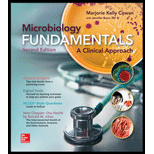
Microbiology Fundamentals: A Clinical Approach - Standalone book
2nd Edition
ISBN: 9780078021046
Author: Marjorie Kelly Cowan Professor, Jennifer Bunn
Publisher: McGraw-Hill Education
expand_more
expand_more
format_list_bulleted
Concept explainers
Question
Chapter 4.4, Problem 16AYP
Summary Introduction
To describe:
The protozoan characteristics that illustrates why protozoa are informally placed into a single group.
Concept introduction:
All protozoan organisms are grouped together as protozoa due to their physical features, and not genetic ties. Most protozoa organisms are free-living and do not cause harm. However, a few protozoa speciesare known to be pathogenic and cause a number of infections in humans.
Expert Solution & Answer
Want to see the full answer?
Check out a sample textbook solution
Students have asked these similar questions
please draw in what the steps are given.
Thank you!
please draw in and fill out the empty slots from image below.
thank you!
There is a species of eagle, which lives in a tropical forest in Brazil. The alula pattern of its wings is determined by a single autosomal gene with four alleles that exhibit an unknown hierarchy of dominance. Genetic testing shows that individuals 1-1, 11-4, 11-7, III-1, and III-4 are each homozygous.
How many possible genotypes among checkered eagles in the population?
Chapter 4 Solutions
Microbiology Fundamentals: A Clinical Approach - Standalone book
Ch. 4.1 - Relate bacterial, archaeal, and eukaryotic cells...Ch. 4.1 - List the types of eukaryotic microorganisms, and...Ch. 4.2 - List and describe the three main fibers of the...Ch. 4.2 - Prob. 1NPCh. 4.2 - Differentiate among the flagellar structures of...Ch. 4.2 - Prob. 4AYPCh. 4.2 - List similarities and differences between...Ch. 4.2 - Describe the main structural components of a...Ch. 4.2 - Diagram how the nucleus, endoplasmic reticulum,...Ch. 4.2 - Prob. 8AYP
Ch. 4.2 - Explain the importance of ribosomes, and...Ch. 4.3 - Prob. 11AYPCh. 4.3 - Prob. 12AYPCh. 4.3 - Differentiate among the terms heterotroph,...Ch. 4.3 - Prob. 14AYPCh. 4.3 - Prob. 15AYPCh. 4.4 - Prob. 16AYPCh. 4.4 - Prob. 17AYPCh. 4.4 - Explain why a cyst stage may be useful to a...Ch. 4.4 - Prob. 19AYPCh. 4.4 - Prob. 2NPCh. 4.5 - Prob. 20AYPCh. 4.5 - Summarize the stages of a typical helminth life...Ch. 4.5 - Prob. 3NPCh. 4 - Prob. 1CTCh. 4 - Prob. 1MCQCh. 4 - From chapter 2, figure 2.1. Discuss how the...Ch. 4 - Prob. 2CTCh. 4 - Prob. 2MCQCh. 4 - Prob. 3CTCh. 4 - Prob. 3MCQCh. 4 - Prob. 4CTCh. 4 - Prob. 4MCQCh. 4 - Prob. 5CTCh. 4 - Prob. 5MCQCh. 4 - Prob. 6MCQCh. 4 - Mitochondria likely originated from a. archaea. b....Ch. 4 - Prob. 8MCQ
Knowledge Booster
Learn more about
Need a deep-dive on the concept behind this application? Look no further. Learn more about this topic, biology and related others by exploring similar questions and additional content below.Similar questions
- students in a science class investiged the conditions under which corn seeds would germinate most successfully. BAsed on the results which of these factors appears most important for successful corn seed germination.arrow_forwardI want to write the given physician orders in the kardex formarrow_forwardAmino Acid Coclow TABle 3' Gly Phe Leu (G) (F) (L) 3- Val (V) Arg (R) Ser (S) Ala (A) Lys (K) CAG G Glu Asp (E) (D) Ser (S) CCCAGUCAGUCAGUCAG 0204 C U A G C Asn (N) G 4 A AGU C GU (5) AC C UGA A G5 C CUGACUGACUGACUGAC Thr (T) Met (M) lle £€ (1) U 4 G Tyr Σε (Y) U Cys (C) C A G Trp (W) 3' U C A Leu בוט His Pro (P) ££ (H) Gin (Q) Arg 흐름 (R) (L) Start Stop 8. Transcription and Translation Practice: (Video 10-1 and 10-2) A. Below is the sense strand of a DNA gene. Using the sense strand, create the antisense DNA strand and label the 5' and 3' ends. B. Use the antisense strand that you create in part A as a template to create the mRNA transcript of the gene and label the 5' and 3' ends. C. Translate the mRNA you produced in part B into the polypeptide sequence making sure to follow all the rules of translation. 5'-AGCATGACTAATAGTTGTTGAGCTGTC-3' (sense strand) 4arrow_forward
- What is the structure and function of Eukaryotic cells, including their organelles? How are Eukaryotic cells different than Prokaryotic cells, in terms of evolution which form of the cell might have came first? How do Eukaryotic cells become malignant (cancerous)?arrow_forwardWhat are the roles of DNA and proteins inside of the cell? What are the building blocks or molecular components of the DNA and proteins? How are proteins produced within the cell? What connection is there between DNA, proteins, and the cell cycle? What is the relationship between DNA, proteins, and Cancer?arrow_forwardWhy cells go through various types of cell division and how eukaryotic cells control cell growth through the cell cycle control system?arrow_forward
arrow_back_ios
SEE MORE QUESTIONS
arrow_forward_ios
Recommended textbooks for you
 Biology: The Dynamic Science (MindTap Course List)BiologyISBN:9781305389892Author:Peter J. Russell, Paul E. Hertz, Beverly McMillanPublisher:Cengage Learning
Biology: The Dynamic Science (MindTap Course List)BiologyISBN:9781305389892Author:Peter J. Russell, Paul E. Hertz, Beverly McMillanPublisher:Cengage Learning Concepts of BiologyBiologyISBN:9781938168116Author:Samantha Fowler, Rebecca Roush, James WisePublisher:OpenStax College
Concepts of BiologyBiologyISBN:9781938168116Author:Samantha Fowler, Rebecca Roush, James WisePublisher:OpenStax College Biology Today and Tomorrow without Physiology (Mi...BiologyISBN:9781305117396Author:Cecie Starr, Christine Evers, Lisa StarrPublisher:Cengage Learning
Biology Today and Tomorrow without Physiology (Mi...BiologyISBN:9781305117396Author:Cecie Starr, Christine Evers, Lisa StarrPublisher:Cengage Learning
 Biology (MindTap Course List)BiologyISBN:9781337392938Author:Eldra Solomon, Charles Martin, Diana W. Martin, Linda R. BergPublisher:Cengage Learning
Biology (MindTap Course List)BiologyISBN:9781337392938Author:Eldra Solomon, Charles Martin, Diana W. Martin, Linda R. BergPublisher:Cengage Learning


Biology: The Dynamic Science (MindTap Course List)
Biology
ISBN:9781305389892
Author:Peter J. Russell, Paul E. Hertz, Beverly McMillan
Publisher:Cengage Learning

Concepts of Biology
Biology
ISBN:9781938168116
Author:Samantha Fowler, Rebecca Roush, James Wise
Publisher:OpenStax College

Biology Today and Tomorrow without Physiology (Mi...
Biology
ISBN:9781305117396
Author:Cecie Starr, Christine Evers, Lisa Starr
Publisher:Cengage Learning


Biology (MindTap Course List)
Biology
ISBN:9781337392938
Author:Eldra Solomon, Charles Martin, Diana W. Martin, Linda R. Berg
Publisher:Cengage Learning